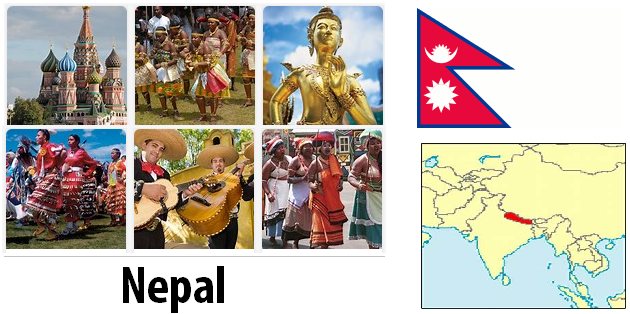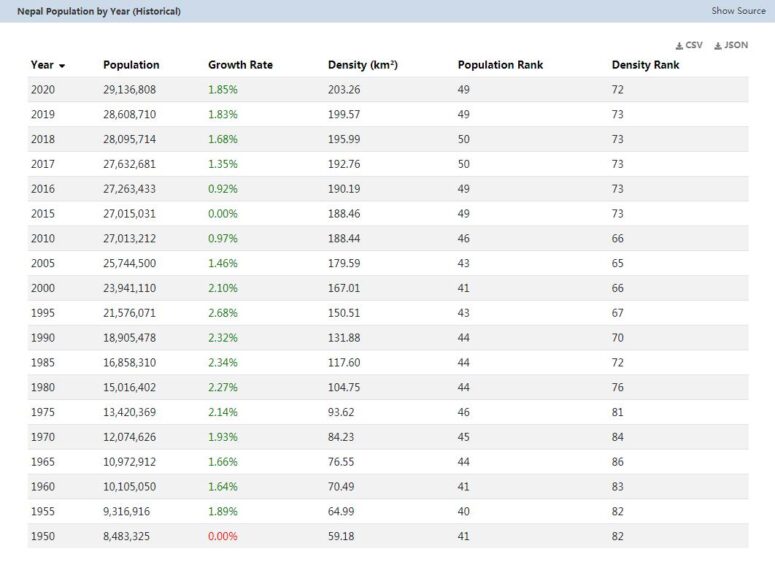Nepal is located in South Asia. It borders the People’s Republic of China in the northeast and India in the southwest. Nepal is home to eight of the world’s ten tallest mountains, including the highest, Mount Everest. Nepal is known as one of the main regions of the Himalayas. In addition to Mount Everest, Nepal has 200 other mountains that are higher than 6,500 meters.
The sights of Nepal are above all the breathtaking nature that is second to none. Nepal is especially ideal for hiking, trekking and mountaineering.
Through Buddhism, the country also has something to offer culturally. Kathmandu, surrounded by mountains, is the capital and cultural and economic center of Nepal. The lively metropolis forms a strong contrast to the quiet life in the country.
Once you get used to the hustle and bustle, there are many culturally interesting places in Kathmandu. Above all, the Durbar Square temple district with its many temples and stupas that are up to 1,000 years old.
In 2001, a census in Nepal found that there are over 100 different ethnic groups in the country. But this also means that the individual ethnic groups have only a few relatives. Therefore, this composition from a variety of ethnicities and cultures in Nepal is called a minority mosaic. In addition to the different cultural and ethnic groups, there are an estimated 124 different languages in Nepal. However, many of the languages and dialects are now threatened with extinction, due to the fact that many of the ethnic groups in Nepal have so few relatives. If the group becomes too small, it often mixes with neighboring ethnic groups and takes over their language. Most of the people living in Nepal come from Indo-Aryan and Tibetan-Burmese groups. Part of the population is the descendants of former refugees.
Area: 147,181 km² (land: 143,351 km², water: 3,830 km²)
Population: 29.4 million people (July 2011, COUNTRYAAH.COM). Chhettri 15.5%, Brahman Hill 12.5%, Magar 7%, Tharu 6.6%, Tamang 5.5%, Newar 5.4%, Muslim 4.2%, Kami 3.9%, Yadav 3, 9%, other 32.7%, unspecified 2.8% (2001 census)
Population density: 200 people per km²
Population growth: 1.596% per year (2011, CIA)
Capital: Kathmandu (822,930 inhabitants, 2006)
Highest point: Mount Everest, 8,850 m
Lowest point: Kanchan Kalan 70 m
Form of government: Nepal is a parliamentary republic, the transitional constitution dates from 2006, in it the royal ones political powers transferred to the Prime Minister. The Parliament (Constituent Assembly) is made up of 601 MPs (240 by direct election, 335 by proportional representation, 26 by the Council of Ministers). Nepal was united on December 21, 1768 by Prithvi Narayan Shah and has been an independent state ever since.
Administrative division: 14 administrative zones (anchal): Bagmati, Bheri, Dhawalagiri, Gandaki, Janakpur, Karnali, Kosi, Lumbini, Mahakali, Mechi, Narayani, Rapti, Sagarmatha and Seti.
Prime Minister: Prime Minister Baburam Bhattarai, since August 29, 2011
Head of State: President Ram Baran Yadav, since July 23, 2008
Language: The official language in Nepal is Nepali, which is the mother tongue of 47.8% of the population. The population is made up of numerous ethnic groups that all speak their own languages: Maithali 12.1%, Bhojpuri 7.4%, Tharu (Dagaura / Rana) 5.8%, Tamang 5.1%, Newar 3.6%, Magar 3.3%, Awadhi 2.4%, Others 10%, unspecified 2.5%. Tourism workers and administrative staff also mostly speak English. (2001 census).
Religion: 80.6% Hindus, 10.7% Buddhists,, 24% Muslims, 3.6% Kirant, 0.9% Others. (2001 census)
Until 2006, Nepal was the only country with Hinduism as its state religion. In April 2006, after the king’s disempowerment, the parliament professed secularism.
Local time: CET + 4:45 h
In Nepal there is no change between summer and winter time.
The time difference to Central Europe is +4: 45 h in winter and +3: 45 h in summer.
International dialing code: +977
Internet ID:.np
Mains voltage: 220 V, 50 Hz
Geography
Nepal is located on the southern Himalayan slopes between the two most populous countries in the world: in the north of China (Autonomous Republic of Tibet), in the west, south and east of India (states of Uttarakhand, Uttar Pradesh, Bihar, West Bengal and Sikkim).
In the north of Nepal, the Himalaya rises with its highest peak, Mount Everest (8,850 m), and there are seven more of the 10 highest peaks in the world. The lowest point in the country at 70 m is in the south, at Kencha Kalan. Nepal is the country with the highest average altitude, more than 40% of the country’s surface is higher than 3,000 m.
Nepal can be divided into three main regions, the Terai, the Mittelland and the high mountain region. These regions differ geographically, ethnically and culturally.
Terai
The Terai, which is relatively low at altitudes between 70 and 150 m, is the Nepalese part of the Ganges plain. It is an important settlement and economic area for Nepal. In the Terai, 47% of the population live in only 14% of the country’s area. The region is fertile and less at risk of erosion than the rest of the country. Due to the year-round frost-free climate and good irrigation options, intensive agricultural use has developed
here. Here, almost all industrial plants are located outside the Kathmandu valley. The Mahendra Highway is the only east-west road through the valley.
Mittelland
The transition between Terai and the 3,000 m high plateau is formed by the Mahabharat chain and Siwaliks. The Mittelland is the long-populated heartland of Nepal. 45% of the population live here on 30% of the country’s surface.
Due to the numerous mountains and valleys, only a few traffic connections were created here. Only the Kathmandu and Pokhara valleys and places like Mugling, Jiri and Dumre are connected by roads. The country’s only international airport is in Kathmandu.
High mountain region
Almost all settlements in the high mountains of Nepal are in valleys. Seasonal settlements for pasture farming are created at an altitude of up to 5,000 m. Due to the steep slopes and heavy monsoon precipitation (sometimes over 5,000 mm per year), soil erosion is very high on the southern slopes. The southern slopes are poorly suited for agriculture.
The northern slopes, on the other hand, are in the rain shadow, here there is very little rainfall (less than 200 mm per year), which also makes agriculture very difficult. Forestry predominates here, and trekking tourism is an important source of income. There are practically no roads here.
Population in Nepal
This map of the population distribution in Nepal was created by the Worldmapper team. Densely populated areas appear bloated, the area of sparsely populated areas is reduced. The shape of the grid has been preserved; an underlying map with the original geographical extent helps interpret the map. The distorted map should help to present abstract statistical information clearly.
Nepal climate
Due to the varied topography, the weather can differ greatly from one region to another. As a general rule, temperatures and precipitation decrease with increasing altitude. In the high-lying deserts of the Tibetan plateau, temperatures are just above freezing for most of the year and it hardly ever rains. From March to April and October to November is the best time to visit Nepal: the days are usually warm with little rain, the sky is usually clear and the temperatures are between 24-28 ° C. From November to March can be night temperatures drop near freezing and snow can block the passes (with hardly any snow falling in Pokhara and Kathmandu). May and early June are unbearably hot and humid from May to September, heavy rain falls on most days. Kathmandu is generally drier than Pokhara during this time, while the Terai practically drowns in the rain.

